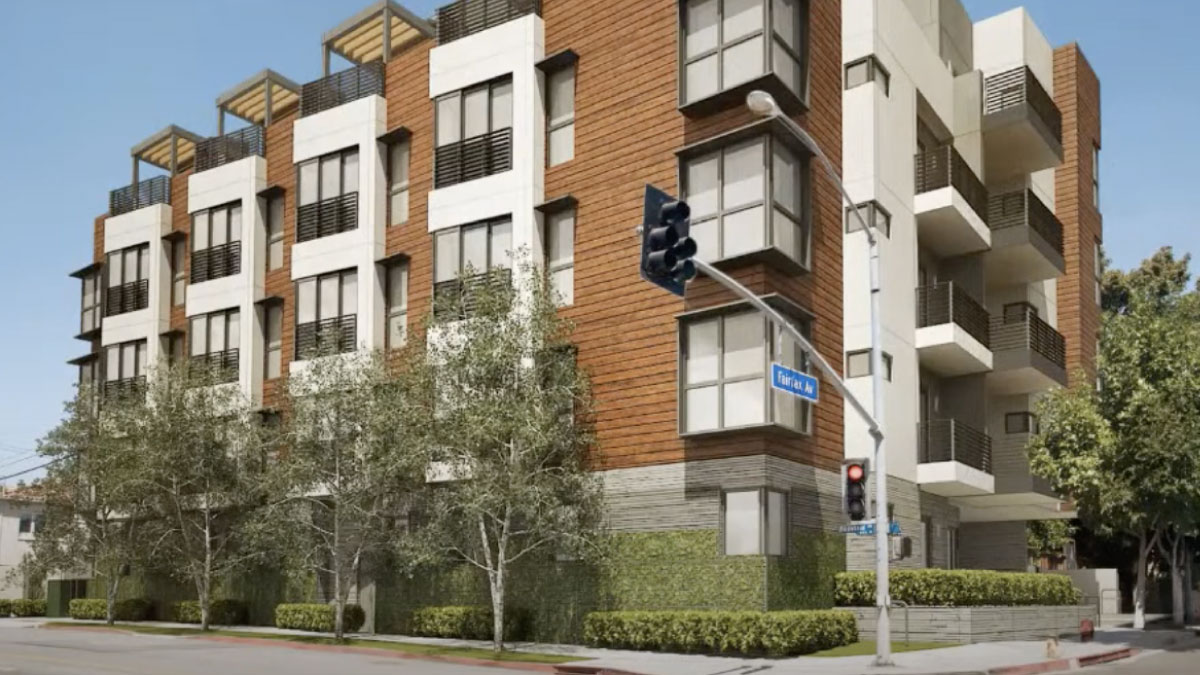Co-living is coming (back) to West Hollywood.
The term — which refers to a living arrangement where residents each have a private bedroom and bathroom but share common spaces (living rooms, kitchens, etc.) — will likely make its way into the city’s Zoning Code by the end of the summer.
The Zone Text Amendment (ZTA) on the table will provide specific definitions, regulations and development standards for this housing type, including how small kitchens, bathrooms, storage spaces and laundry areas can be, as well as rules for operation, management and security.
City Hall believes co-living can “address housing affordability by providing residents with lower-cost living options through shared amenities and spaces, making the city more accessible for diverse economic groups. Additionally, co-living encourages community engagement and social interaction, which can enhance the social fabric and cohesion within neighborhoods.”
The city encourages residents to share their opinions on co-living via the Engage WeHo page before City Council reviews the amendment and decides whether or not to adopt it.
What the new law does
The amendment defines a “Co-living housing building” as a residential or mixed-use structure with five or more co-living units, where at least 75% of the total floor area in a residential building and above the first floor in a mixed-use building is devoted to co-living units. A “co-living housing unit” is defined as habitable rooms in a co-living building that include a bathroom, sink, refrigerator, and microwave, and comply with specific code sections.
Co-living housing buildings will be permitted in the city’s R3 and R4 multi-family residential zones. Developments that meet city requirements will be able to receive a density bonus of 40 percent or 50 percent if they meet the city’s and state’s affordable housing requirements. Additionally, a height increase may be permitted to accommodate the increased density.
Each co-living housing unit must be occupied under separate lease agreements for each bedroom. This implies that each resident has a legally binding contract for their specific living space, while also having rights to common areas.
The amendment includes these mandates:
- All shared common spaces, such as living rooms, kitchens, and recreational areas, must be maintained by the building owner or operator.
- Pets are allowed in accordance with existing city policies.
- Each bedroom/bath Suite under individual leases must have separate mailbox provisions.
- A full-sized refrigerator with a freezer (minimum 36” wide) for up to four co-living housing units is required. Each additional four co-living housing units, or fraction thereof, shall require an additional refrigerator and freezer. Permanent cooking facilities must include, at minimum, a full-sized 36” oven and four-burner cooktop.
- Utility closets or mechanical rooms are required to have a minimum area of 20 cubic feet per co-living unit, accessible on each facility floor.
- A cleaning supply storeroom or janitorial closet with at least one utility sink with hot and cold running water must be accessible to all units on each facility floor.
- Laundry facilities must either be provided at a ratio of one washer and dryer for every 12 units or included within each unit.
- Common shared living areas must provide at least 100 square feet per co-living housing unit, not including janitorial storage, laundry facilities, and common hallways.
- Dining areas must offer a minimum of 5 square feet of common shared space per co-living housing unit.
- Kitchens in co-living housing buildings need to meet specific component requirements, such as sufficient food preparation counter space and appropriate storage and appliance provisions
- Units must be accessed directly from common kitchen, dining, or living areas, without separate external entryways.
- Every unit must have external operable windows on at least two exposures to ensure natural light and ventilation. If only one exposure is provided, it must include a minimum of 60 square feet of window area, with at least 50% being externally operable.
- A minimum of 115 cubic feet of closet space or designated storage space is required.
Co-living’s history in WeHo

City Council directed staff to initiate the Zone Text Amendment in June 2021 to clarify and define various housing types in the Municipal Code, specifically co-living housing projects.
In August 2021, developers proposed a complex on Fairfax and Fountain that would have housed 80 people in just 17 co-living units with only 40 parking spaces. The proposal, promising “insanely cheap affordable units,” faced challenges due to the lack of existing ordinances for co-living spaces. After revisions, which added a unit while reducing bedrooms from 80 to 73 and parking spaces from 40 to 32, the Planning Commission approved the project.
The approval was short-lived, as the project faced an appeal from community members challenging the development based on its presentation and potential environmental impacts. This led to a City Council meeting on December 5, 2021, where the project was scrutinized further, particularly concerning its treatment of affordable units and the practicality of the co-living model in accommodating diverse family structures.
“I’m very concerned about limiting the number of people per bedroom,” former Councilmember John D’Amico said. “If someone gets pregnant or adopts a child, they’re basically evicting themselves. If someone falls in love, they’re basically evicting themselves.”
Then-Councilmember John Erickson proposed significant changes to the configuration of the affordable units, advocating for their dispersion throughout the building to better integrate with other units. This motion, emphasizing a more inclusive and equitable approach to the design, was accepted with a 4-1 vote, directing the Planning Department to revisit the plans.
Potential problems
Co-living, while a novel approach to addressing urban housing shortages and high rental costs, has not been without controversy and challenges.
Co-living developments have been set up without proper adherence to local zoning laws or building codes, leading to legal conflicts. For example, certain co-living spaces may operate similarly to hostels without the appropriate licensing, which can lead to shutdowns or fines.
In some cases, residents have reported being evicted with minimal notice due to the informal nature of their rental agreements, which don’t always provide the same protections as traditional leases. This has raised concerns about the stability and security of tenants, particularly in cities with strong tenant protection laws. This issue has been particularly poignant in tech-heavy cities like San Francisco, where rapid changes in housing stock and tenant demographics have intensified debates over tenant protections.
While co-living is touted as a more affordable housing option, the actual cost savings can sometimes be less significant than anticipated. The pricing of co-living spaces in markets like New York City has sometimes approached or even exceeded that of traditional apartments, raising questions about the model’s effectiveness in truly addressing housing affordability.
Overcrowding has been a problem in some co-living arrangements, particularly when operators exceed occupancy limits to increase profitability. This can lead to unsanitary conditions, increased wear and tear on facilities, and heightened risk of fire or other safety hazards.
Cases have been reported where the lack of soundproofing and personal space leads to conflicts, which can escalate if not managed properly.


Just wait until someone leaves their dirty dishes in the communal sink……..
It’s nothing more than a dorm room for adults. A developers wet dream!!
I always thought it was just called getting a roommate. I never knew it was so complicated!
“Co-living” = We young people can no longer even afford our own studio apartment in WeHo. This is awful, like NYC, where you’d have 2 or 3 in a studio just to be able to afford it. Make it stop! Bring back (relatively) affordable living. The WeHo that was so awesome for decades is no more, and that makes me sad. And mad.
Sounds great until someone gets raped or murdered. This is a disaster waiting to happen.
Decades ago, these were call tenements. We learned back in the early 20th century that these were bad for a human’s quality of life and people fought to eliminate them. Seems like this council is determined to repeat many of the horrible practices of the past.
I remember when these popped up downtown 10 years ago in the hectic Toy District. Despite the fancy exteriors, it was troubling to see college educated/full time/public health workers etc sharing a kitchen/communal bathroom for a floor. That’s when I knew it was the beginning of the end of affordability in LA.
Why not just move in with a roommate? There are over 200 advertised opportunities on any given day in Weho for under $1,000/month.
Sounds good on paper but wait until human nature enters the mix!
Inhumanity cloaked in wokeness.
yup.
Yep.
From the city which is supposed to stand for “pride”. So embarrassing and shameful for council to even consider this.